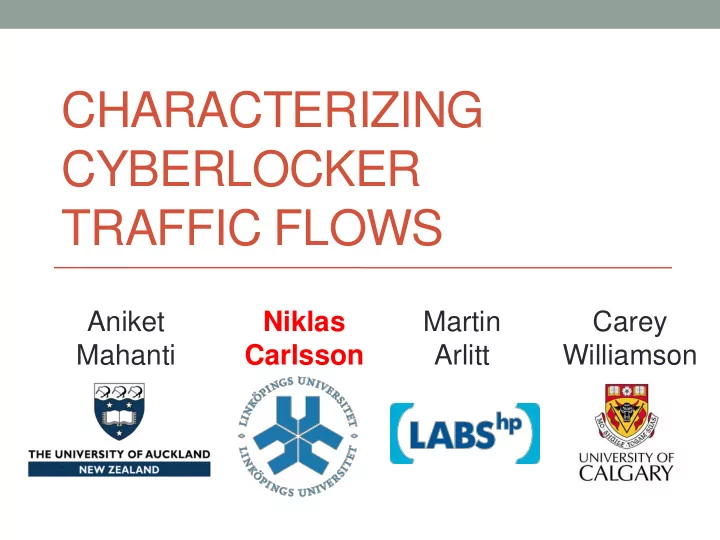

CHARACTERIZING CYBERLOCKER TRAFFIC FLOWS Aniket Niklas Martin Carey Mahanti Carlsson Arlitt Williamson
2 Introduction • Cyberlocker services provide an easy Web interface to upload, manage, and share content. • Recent academic and industry studies suggest that cyberlocker traffic account for a significant fraction of the Internet traffic volume. • Usage, content characteristics, performance, and infrastructure of selected cyberlockers have been analyzed in previous work. • In this work, we analyze flows originating from several cyberlockers, and study their properties at the transport layer and their impact on edge network .
3 METHODOLOGY
4 Data Collection • Flow-level summaries were collected using Bro from a large university edge router between Jan. 2009 – Dec. 2009 • HTTP transaction summaries used to extract IP addresses of top-10 cyberlocker services for mapping the flows.
5 Characterization Metrics • Flow-level characterization • Flow size: The total number of bi-directional bytes transferred within a single TCP flow. • Flow duration: The time between start and end of a flow. • Flow rate: The average data transfer rate of a TCP connection. • Flow inter-arrival time: The time between two consecutive flow arrivals. • Host-level characterization • Transfer volume: The total traffic volume transferred by a campus host during the trace period. • On-time: The total time the campus host was active during the trace period.
6 Distribution Characterization and Fitting Number of flows Many small values Few big values Metric value
7 Distribution Characterization and Fitting CDF to view CCDF to view Number of flows Many small values (body) Metric CDF to view Few big values (tail) Metric value
8 Distribution Characterization and Fitting CCDF to view Number of flows Many small values (body) Metric CCDF to view CDF to view Few big values (tail) Metric value
9 Distribution Characterization and Fitting CDF to view CCDF to view Number of flows Many small values (body) Metric CCDF to view CDF to view Few big values (tail) Metric value
10 Distribution Fitting and Model Selection • Complexity of the empirical distribution required us to apply hybrid fits of candidate distributions, where we fit the empirical distributions piece-wise. • Each empirical distribution was divided into pieces based on manual inspection. • We fitted seven well-known non-negative candidate statistical distributions ( Lognormal, Pareto, Gamma, Weibull, Levy, and Log Logistic ) to each piece and calculated the nonlinear sum of least square error. • The statistical distribution with the lowest error was chosen. • After fitting all the pieces of the empirical distribution, we generated the P-P and Q-Q plots; the goodness of the fit was determined by manually inspecting these plots.
11 Goodness of Fit (a) Fit of body (majority of flows) (b) Fit of tail (rare-extreme values)
12 DATASET OVERVIEW
13 Trace Summary Service Host Flows Bytes Mega Network (%) 75 43 68 Characteristic Count RapidShare (%) 41 42 13 Flow summary 1 TB zSHARE (%) 35 4 8 log size MediaFire (%) 34 8 3 HTTP traffic 4 billion flows Hotfile (%) 5 0 2 HTTP traffic volume 488 TB Enterupload (%) 30 1 2 Top-10 cyberlockers 7 million flows (0.19%) Sendspace (%) 11 1 1 Top-10 cyberlocker 22 TB (4.5%) traffic volume 2Shared (%) 7 0 1 Campus hosts 13,000 hosts Depositfiles (%) 8 1 1 using cyberlockers Uploading (%) 5 0 0 Top-10 cyberlockers 13K 7 mil 22 TB
14 Campus Usage Trends
15 FLOW-LEVEL CHARACTERIZATION
16 Flow Size Cyberlocker Model: Lognormal-Pareto Cyberlocker Content Model: Lognormal • Content flows only represent 5% of the cyberlocker flows, they consume over 99% of the total traffic volume. • Content flows are orders of magnitude larger as they transfer large content hosted on the sites. • Significantly larger flows than typical Web object.
17 Flow Duration Cyberlocker Model: Gamma-Lognormal- Pareto Cyberlocker Content Model: Lognormal-Gamma • Content flows are long-lived, partly due to wait times and bandwidth throttling. • Most content flows have duration less than 10 minutes due to medium-sized content downloads.
18 Flow Rate Cyberlocker Model: Gamma Cyberlocker Content Model: Gamma-Lognormal • Cyberlocker content flows are larger and long-lived and receive higher flow rates. • There is presence of both free and premium hosts that download content from the services.
19 Flow Inter-arrival Cyberlocker Model: Lognormal-Gamma Cyberlocker Content Model: Gamma-Lognormal • Parallel downloading increases flow concurrency and decreases flow inter-arrivals. • Content flow inter-arrivals are longer because there are far fewer such flows; most of the flows are due to objects being retrieved from sites.
20 HOST-LEVEL CHARACTERIZATION
21 Host Transfer Volume Cyberlocker Model: Lognormal-Pareto • There is presence of some hosts that transfer a lot of data as well as hosts that transfer less data. • Most of the transfer volume is due to content flows.
22 Heavy Hitters • The top-100 ranked hosts account for more than 85% of the cyberlocker and cyberlocker content traffic volume. • The high skews are well-modeled by non-linear power-law distributions.
23 Host On-time Cyberlocker Model: Gamma-Lognormal • On-times of cyberlocker hosts are heavy-tailed • Most of the time spent by hosts is for downloading content. • Users with premium subscription may spend less time since they can download more content in less time.
24 CONCLUDING REMARKS
25 Conclusions • Cyberlockers introduced many small and large flows. • Most cyberlocker content flows are long-lived and durations follow a heavy-tailed distribution. • Cyberlocker flows achieved high transfer rates. • Cyberlocker heavy-hitter transfers followed power-law distributions. • Increased cyberlocker usage can have significant impact on edge networks. • Long-lived content flows transferring large amounts of data can strain network resources.
26 Aniket Mahanti – University of Auckland, New Zealand Niklas Carlsson – Linkoping University, Sweden Martin Arlitt – HP Labs, USA Carey Williamson – University of Calgary, Canada QUESTIONS?
Recommend
More recommend